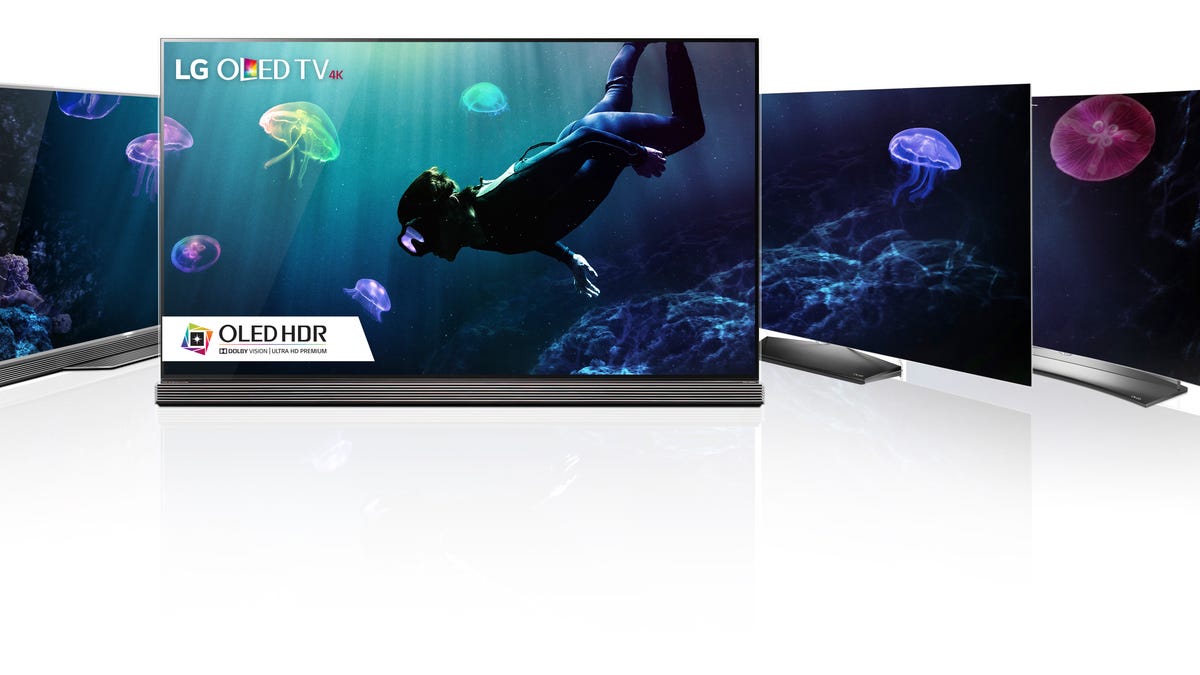LG OLED TVs aren't getting any cheaper
OLED TVs belt out the best picture quality CNET has ever tested, and LG has finally released pricing information for its 2016 line. They start at $4,000 for the 55-inch size.

If competition drives prices down, the flipside of that logic is that lack of competition keeps prices high. And that seems to be the case with LG's OLED televisions.
The Korean manufacturer -- sole producer of big-screen TVs that utilize organic light-emitting diode (OLED) display technology -- has just announced pricing for all of its new 2016 models. They start at $4,000 for the 55-inch size, and $6K for the 65-inchers.
In case you haven't been TV shopping in awhile, that's a lot of money even by high-end standards. Sony's most-expensive equivalent TVs, the XBR930D series, cost half as much, while Samsung's best 65-inch TV, the UN65KS9800, is $1,500 less.
Of course, those models use LCD display technology that, in our tests, can't match the prowess of OLED, particularly in dark home theater settings and when seen from off-angle seats. Moreover, Samsung and Sony don't support the Dolby Vision high-dynamic range (HDR) format, while LG handles both HDR10 and Dolby Vision. HDR promises -- and mostly delivers, in our tests -- even better picture quality than 4K resolution.
Those factors make LG's OLED TVs our prohibitive favorites for best money-no-object TVs of 2016. For most people, however, money is an object, and if you're in the fortunate position of actually being able to afford one of these sets the calculus becomes pretty complex.
For example, LG's 2015 OLED models like the 65-inch 65EF9500 are phenomenal performers themselves. That TV currently goes for $4,500 at Amazon and Best Buy -- or significantly less at places like eBay, where sellers promise new, in-box sets for steep discounts. And the best value in OLED continues to be the $2000 55EG9100, a 55-inch set with 1080p resolution (not 4K). LG will continue selling it throughout 2016.
On the other hand, last year's OLEDs don't support Dolby Vision, and according to LG fall a bit short of the new models' picture quality. See the bottom of this post for details.
Here's a rundown of LG's official prices.
2016 LG OLED TVs
| Model | Size | Price | Screen shape | 3D capable | Design |
|---|---|---|---|---|---|
| OLED55B6P | 55 inches | $3,999 | Flat | No | Standard |
| OLED65B6P | 65 inches | $5,999 | Flat | No | Standard |
| OLED55C6P | 55 inches | $3,999 | Curved | Yes | Standard |
| OLED65C6P | 65 inches | $5,999 | Curved | Yes | Standard |
| OLED55E6P | 55 inches | $4,999 | Flat | Yes | Picture-on-glass |
| OLED65E6P | 65 inches | $6,999 | Flat | Yes | Picture-on-glass |
| OLED65G6P | 65 inches | $7,999 | Flat | Yes | Picture-on-glass with sound bar stand |
| OLED77G6P | 77 inches | TBD | Flat | Yes | Picture-on-glass with sound bar stand |
LG says they're all shipping now, with the exception of the 77-inch model. Amazon has been selling the more-expensive series, the E6 and 65-inch G6, for a few weeks now, but this is the first official word we have of B6 and C6 pricing.
LG deserves credit for admitting up front that all of these TVs will have the exact same picture quality, rather than tacking on some dubious picture enhancement to induce buyers to step up.
The only differences are noted above, and come down to screen shape (the lone curved series is the C6), 3D (the B6 is the only non-3D model) and styling. Here's what the press release says about the latter, with bombast mostly edited out:
The..."Picture on Glass" [G6 has] an exceptionally thin depth (measuring about one-tenth of an inch), a translucent glass back and a...sound bar that doubles as a unique stand. The E6...also boasts an ultra-slim profile with a similar "Picture-on-Glass" aesthetic and traditional...stand.
Given identical pictures, along with my preference for a flat screens and inability to care about 3D, I'm targeting the B6 series as the pick of the litter. LG says a review sample is will arrive in the next few weeks. In the meantime, here's the updated picture quality section from my CES writeup.
A bit brighter and more colorful than 2015
In terms of picture quality, a couple things have changed between the new OLED models and the 2015 sets, but nothing ground-breaking enough to make 2015 buyers regret their purchase.
The newer sets boast a 25 percent higher brightness than last year, which is more important in the ongoing specs-manship battles with ultra-bright LED LCD displays than it is in real life. LG didn't cite an actual brightness level in nits, but did tell us that they will hit the 540 nits (a unit of light output) required for UHD Alliance certification. We measured around 440 nits for the 2015 models.
That's about half the brightness of Samsung and other LED LCD makers' displays, which cite 1000 nits, but in our HDR tests so far, we still prefer OLED despite LCD's brightness advantages.
The 2016 models also boast a somewhat wider color gamut, delivering a claimed 99 percent of the DCI color space compared to around 88 percent for the 2015 versions, according to our measurements.
Speaking of tests, one of the few issues we noticed on LG's OLED TVs is uneven uniformity in some very dark scenes. LG's engineers claim to have improved the issue with the 2016 models. We can't wait to test them.

